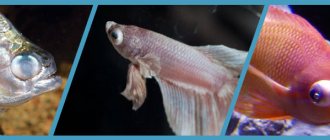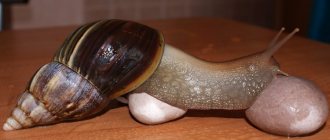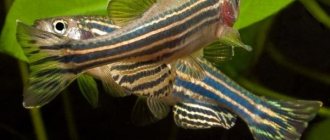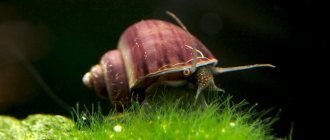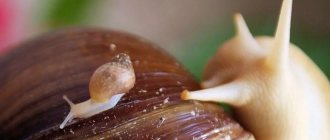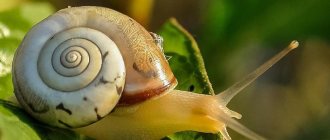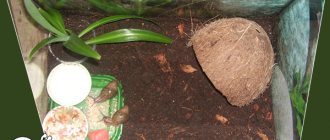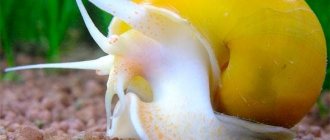Recently, snails have become very popular pets. They are easy to care for, do not take up much space, and are very interesting to watch. But these mollusks are very fragile and therefore need to be handled very carefully. Very often, beginning snail breeders ask the question: “The snail’s shell is broken, what should I do?” And we will answer it in our article, we will describe the main reasons for this phenomenon and how you can help the mollusk.
A snail's shell is the external skeleton of a mollusk, inside which vital organs are hidden. The shell is attached to the snail's body by muscles. The snail is born with its shell, and the shell grows along with the mollusk. The shell, like other parts of the snail’s body, has the ability to regenerate, that is, it is restored over a period of time.
The most active growth of the shell is observed in the first year of the mollusk’s life. Therefore, the main component of a snail’s diet should be calcium, since consuming this element will strengthen the shell and prevent it from breaking when falling. The most accessible source of calcium is eggshells, which must be thoroughly washed, dried, crushed and fed to pets in this form.
Treatment options
There are several methods to help a snail with a cracked shell.
Method one: plaster and glue
First of all, you should clean the damaged areas from contamination. This is done by washing in warm water from 26 to 30 degrees. After the broken Achatina shell has dried, you will need a piece of plaster. Architectural clay is also suitable. This composition should be used to cover the damaged area. It is important to apply the raw material in thin layers and not press on the shell with all your might.
As a rule, plaster dries within 24 hours. After it has completely dried, the application area is covered with glue - medical, epoxy or super compound. The liquid should be used extremely carefully, as it is harmful to the mollusk. Even one drop falling on the body can lead to death of the animal. The glue also dries within 24 hours, after which the snail is reintroduced back to its relatives.
Method two: patch
This option is used if Achatina’s shell is not too broken. It is acceptable for small cracks and chips. The procedure follows the first method: the animal is separated from its fellows, the shell is washed, and the crack or chip is covered with a band-aid.
Main sources of calcium
- Raw or boiled eggshells ground in a coffee grinder;
- Crushed food chalk. Colored crayons and school chalk cannot be used, as they contain chemicals;
- Sepia. If you buy or collect sepia on the seashore, make sure that it is not salted. Salt is the certain death of a snail. How to desalinate sepia;
- Crushed shell rock;
- Nutrient supplements with bone meal, daphnia and gammarus;
- Cottage cheese, milk and other goodies.
I read on one snail breeding forum that tablets of calcium gluconate were used as a source of calcium. I decided to try it, crushed the tablet into powder and poured it into the snail terrarium. After a few hours, Achatina began to secrete a lot of mucus, and her leg became swollen. I treated her for poisoning for several days. So don't repeat my mistake, calcium gluconate is a chemical, feed your snail natural calcium.
So, peeling of a snail shell can be caused by various reasons, so treatment must be approached in a comprehensive manner.
Prepare a proper diet, carefully select soil, clean the terrarium daily, and do not keep Achatina in crowded conditions. May your snails be healthy. If the article was useful or you want to add something, please leave a comment.
Ways to prevent damage
There are options in which you can avoid breakage of Achatina’s shell:
- Keeping the house clean and tidy. It is unacceptable to place hard objects such as stones on the bottom of the house.
- Selecting quality soil.
- Balanced diet and mandatory calcium supplements.
- Maintaining a balance of temperature and humidity in the terrarium.
Simple rules will help you avoid a lot of troubles and maintain your pet’s health at a high level.
Why does the sink peel?
If the Achatina shell has become fragile, flakes and flakes, then the snail suffers:
- from a lack of calcium in the body;
- from a lack of vitamins and protein in the body;
- from being kept on sandy or rocky soil;
- from swimming in chlorinated water;
- from a fungal infection;
- from a cramped and densely populated terrarium.
If you notice that your pet has a peeling shell or small chews, isolate him from others if possible. Include different types of calcium in your diet, prepare a calcium mixture from eggshells and shell rock or ground sepia and edible chalk.
Feed him low-fat cottage cheese, and in the evening give him a warm bath with milk. Then wipe the shell of the mollusk with an oily solution of vitamins A and E. Every day, inspect the snail for the appearance of new peelings and gnaws. If these appear, treat the shell with a weak solution of manganese or iodine, the snail will stop gnawing on it.
See more similar articles:
Snail sleep, hibernation, Achatina leaving the coil, what to do...
The Achatina snail does not want to eat, what should a snail breeder do?
Back Forward 1 of 6
Watch a video on how to stop a snail from chewing its shell
If feeding rules are not followed, the snail begins to hurt. In order for her to grow and develop well, her diet must consist of fiber, calcium and protein. I even dedicated an entire article to this.
I also ask you not to bathe your Achatina under the tap. Tap water is rich in heavy metals and chlorine, which dries out the sink and leaves a white residue on it. Not to mention the terrible burns on the snail's body from the uncontrolled supply of hot water in the tap. Learn more about bathing a snail.
Knowledgeable snail breeders bathe Achatina only in purified water with the obligatory treatment of the shell with natural vegetable oil or ointment with propolis. However, any remaining oil or ointment must be removed.
A common cause of shell peeling is improper maintenance conditions. For example, Achatina is kept on sandy or pebble soil. Sand and stones mercilessly scratch the Achatina shell, and when the mollusk falls on the stones, the shell cracks or completely splits, which leads to painful death.
Unsanitary conditions for keeping the snail, a waterlogged substrate, and rotting remains of fruits and vegetables lead to the appearance of mold, fungi and parasites in the terrarium. Due to the terrible conditions of detention, the snail’s shell begins to exfoliate and collapse; if nothing is changed, the mollusk will die. What to do?
Parasites and worms in the Achatina snail
Snails, like other pets, can be infected with parasites - nematodes and trematodes. Some of the worms are dangerous to humans. Fortunately, under the right conditions, the chance of encountering parasites in a domestic snail is minimal. You can notice the worm by carefully examining the body of the mollusk or its feces. The problem cannot be ignored, since the worm slowly kills the snail, and a person can become infected with some worms from it.
So, you have found worms in Achatina snails, how to treat your pets? First of all, you need to carry out a general cleaning of the terrarium, completely replace the soil, rinse the container with water and soda and pour boiling water over it. Remember that aggressive detergents cannot be used - their residues cause burns to snails. Anthelmintic drugs are not used for dogs or people; they are toxic to shellfish. Treatment of helminthic infestation includes:
- bathing in a warm decoction of wormwood and tansy;
- adding ground raw pumpkin seeds, fresh cucumber and carrots to the diet.
Worms in Achatina do not appear from the air; they can be brought in from poorly washed greens, contaminated soil or a sick animal. To prevent parasites from appearing in Achatina, thoroughly wash greens and vegetables before giving them to your pets. Be sure to quarantine your new pet for a month. Keep the terrarium clean and remove uneaten food and animal waste. For prevention, regularly feed pumpkin seeds.
Snail in an aquarium
The horned snail is perfect for populated aquariums where there are no predatory fish, such as loaches, large cichlids, macropods, and Helena snails. Clithon corona are social animals, so they must be introduced into the aquarium in numbers of at least five individuals. Bumblebee Nerites have a peaceful nature and do not offend other inhabitants of the aquarium, nor do they damage plants. You can plant any plants in the aquarium; these mollusks will not touch them, but, on the contrary, will help get rid of the accumulation of various algae on their leaves. Horned clams only eat dead or decaying matter.
Clithon corona is excellent at cleaning aquarium walls, driftwood and plants from organic waste and algae. Due to their size, these little ones can get into places that are difficult for most aquarium inhabitants to reach and clear algae there. Horned snails are very light and can sit on small and thin leaves of aquarium plants.
Signs of disease in a pet gastropod
Responsible breeders examine their dogs daily and monitor their physical and emotional condition. At the first signs of a disease, it is necessary to urgently take measures to prevent the torment and death of delicate, defenseless mollusks.
If Achatina was in the wind or exposed to direct rays of the sun, then it may become hypothermic or overheated.
In both cases, a nice bath at room temperature or a warm shower will help her.
Salt and household chemicals are the main enemies of helpless creatures. When corrosive substances get on the skin or internal organs of a mollusk, it secretes abundant white foam. Every owner should know the list of prohibited and dangerous products. How to treat the Achatina snail in case of acute poisoning? You can save your pet from suffering by bathing under running water, in milk or in blue clay. If therapy doesn't help, the poor clam will have to be frozen!
Achatina’s apex was broken off, the internal organ was facing out
Actually, the description of the problem from my topic: Quote: Last night I decided to anoint all the snails with Prodevit, since the drug contains vitamin D3, and it is greasy and Achatina Orpheus slipped out of my hands. Subsequently, the apex is broken off, the muscle outwards. I had to boil the egg and carefully peel it, extracting a film to cover the muscle. While I somehow stuck a plaster on top. I see Orphey is active and eating. I didn’t plant it separately. As you understand, Achatina’s apex has been broken off; until recently, the internal organ was exposed. The organ has now been pulled into the shell by the snail and is not visible at all. This probably doesn’t even belong in the section on problems with the sink, that’s why I wrote it here. Here's another entry from my topic Tenants from Amaranth Skyscrapers today: Quote: How are things going with the tiger. In general, it’s bad, but I hope everything will work out. Today I'm specifically scared. At night the patch came off and the tiger spent the night “without an apex.” The curl sticking out is not visible in the sink, nor is dirt. I climbed into the terr to show my brother how it was broken in order to plan the gluing. The tiger's head is swollen, the body is soft, but the snail is moving. I quickly ran it under the tap, then into a warm bath and dropped a few vitamins: maybe he’ll try to drink it? Looks like he was drinking. I read a long time ago that you can drink cucumber juice without eating a snail. I don’t have a juicer, so I grated the cucumber on a fine grater. The tiger lingered on some hillocks; the movements of the radula were poor, but visible. Maybe I tried to eat it. I also scared him. After my actions, he shrank and tried to get out of the bath. I also think it would be advisable to bathe him in chamomile and if he gets bloated again, then in medicine. What medications do you recommend?
_________________________________________ Orchids and snails
In the evening a tiger crawled along the walls. Overnight it swelled again. In the morning I sat with my head in a shell. The action plan for today is to bathe in chamomile, and if I don’t eat after that, then I’ll head to the pharmacy for metronidazole. But what dose should I give? Good people, please don’t be silent!
_________________________________________ Orchids and snails
Are you bathing a hive with a hole? The shell urgently needs to be sealed, rather than the snail being treated. Read about repairs in the archive
I haven’t bathed in anything yet, and if I did, I would raise the apex. I spent all day shopping at hardware stores and couldn’t find glue, Poxibol, or epoxy. In the largest center there is epoxy. ended. There is also a problem with medical plaster, medical technicians and hospital pharmacies are not open on Sundays, so I had to take a plaster bandage. They closed the hole with it, and instead of glue I’ll probably use silicone for lack of a better option. The snail is neither better nor worse. It sits on wet paper, which is lightly sprinkled with activated carbon. He's trying to crawl and seems to be trying to eat coal. The head either inflates or is normal, only the horns do not protrude completely. The head is clean, without rash or visible injuries. I bought Metronidazole. At the pharmacy I realized that I had mistakenly thought that metronidazole and trichopolum were different drugs) Is half a tablet per tablespoon a normal dose? Or even less?
How to keep your Achatina snail healthy
Diseases most often attack an animal weakened as a result of improper maintenance. It is important to avoid overcrowding the terrarium; in crowded conditions, pets will get sick more often. One snail requires a volume 5 times larger than itself, that is, approximately 20 liters per individual.
The terrarium should not be placed in the sun; overheating leads to the death of animals. The best soil is coconut substrate. Moss is used as an indicator of humidity - if it is green, there is enough moisture, if it is dry, irrigation is necessary. Keep your snails' house clean, removing uneaten food immediately, otherwise rot and mold will appear.
Meals should include fresh fruits, vegetables, calcium, plant and animal protein (the latter in limited quantities). It is strictly forbidden to give salty foods to your pets. Thoroughly sterilize the soil, decorations and other accessories of the terrarium to avoid introducing parasites. Follow these rules - and your pets will be healthy!
The sink has cracked, what should I do? (((
My children are delighted with it. Colorful, kind and teaches good things to our children. Unlike Western ones." Added -
Littleone 2009-2012 > Hobbies and interests > About pets > Achatina broke his shell, help!
View full version: Achatina broke his shell, help!
I wrote in a thread about snails, but no one has responded yet. What to do? There was no injury, the shell just began to crumble, and the snail kept breaking it all night. Only the upper half of the shell remained, and all morning the snail lay there, torn to pieces, with a dying look. And now she is NAKED with a small piece of shell on top, cheerfully cutting through the aquarium. But she can’t live like that. Can she still be saved?! The shell was always fragile, although I kept adding crushed calcium gluconate. And yet, for some reason this snail always preferred the mold that grew on them to bananas and any vegetables. Is this even normal? Is there anything I can do for the poor animal?
Go to the topic about snails https://www.forum.littleone.ru/showthread.php?t=223373 maybe they will help the animal there...
I wrote in the topic this morning, but no one has responded yet. the veterinarian told me to keep the body moist, but nothing else... and that she clearly has metabolic abnormalities, since she only likes mold, and that calcium gluconate should be replaced with chalk or shells. But this is not emergency help.
It's better to have a cuttlefish shell than chalk
and where can I get this?
I buy shell (Sepia) at a pet store, but in the parrot food department, be prepared for the fact that they won’t answer the question of where you have sepia or cuttlefish shell, I’ve already encountered this.
How to find out that the Achatina snail is sick
Diseases of Achatina snails are not always noticeable from the first symptoms. Although the mollusk cannot complain about its health, its body gives signals. Signs that indicate a snail problem are:
- behavior change: lethargy, refusal to eat, hibernation;
- deterioration in appearance: the appearance of atypical mucus, growths on the shell;
- cracks, delaminations and other damage to the shell;
- deep immersion in the sink, care for the coil.
It is also necessary to closely monitor the snail after situations in which the pet could have been injured. Even if you think everything is fine immediately after the incident, the consequences may appear later.
Causes of shell damage
The most common cause of a cracked shell in Achatina and other snails is a fall. The mollusk may accidentally slide down from the walls of the terrarium or fall, slipping out of the hands of the owner, who planned to bathe it in a stream of running water. Despite the apparent strength of the cover, it is quite fragile
Therefore, if a snail’s shell is cracked, it is important to know what to do and how to treat it.
Algorithm of actions
- Thorough inspection of the damage and assessment of its extent.
- If the Achatina’s chip is so small that it is almost unnoticeable, then, most likely, the fragments of the shell do not affect the internal organs and the mollusk is able to restore itself on its own. It is enough to help your pet and give increased portions of calcium for some time.
- If the shell of the Achatina snail breaks into small pieces, emergency and urgent measures will be required. The first is to move the animal to a separate container, away from neighbors in order to avoid cannibalism.
Chemical burn and poisoning
When burned or poisoned by chemicals, 96% of individuals die. Contact with harmful substances
possible in the following cases:
- the food that came into the bowl was treated with pesticides;
- the owner did not wash the ulitharium well after cleaning it;
- salt got into the house, which is harmful to the mollusk.
If the breeder notices that the shell is foaming and bubbling, and the body is covered with white mucus, you can try to save the pet. To do this, Achatina should be washed under water. If this does not help, then death is inevitable. In this case, the best option is to put the animal in the cold. There it will die in its sleep, without suffering.
You can avoid chemical exposure by thoroughly washing the soil and rinsing the aquarium. You should not resort to the use of chemicals to clean the house, and the snail itself should not be released outside of it unnecessarily.
How to stop shell destruction in aquarium snails?
I don’t know why, but in recent years the opinion has increasingly been heard among aquarists that snails are “aquarium weeds”, parasites, and in general - a rare disgusting thing that would be better off not existing in the world at all. If earlier in the books of the classics of Russian aquatic literature, detailed stories, along with fish, were devoted to both reels and physes (other snails, even if they ended up in the aquariums of our compatriots, were extremely rare), but now in relation to these animals, most often only conversations are heard : how to lime them as quickly and efficiently as possible, if they - bad luck - ended up in the aquarium along with the purchased plants.
To be honest, such discussions leave a bitter taste. You begin to seriously think how much we have been spoiled by foreign suppliers who are now ready to fulfill any whim of the aquarist - if only there was money. Somehow the sympathies of the majority have shifted greatly: now, first of all, rare and expensive fish (snail, shrimp, crayfish...) are considered worthy of attention. Familiar from childhood, accessible and easily bred species are already perceived almost as “garbage”... As if they are valuable not in themselves, but only based on the opportunity to show them off to guests and cause exclamations of surprise with another new product.
Fortunately, such distortions did not infect everyone. Therefore, today we are publishing this material just for those who are not only not disheartened by the presence of coils, physes, melanias and other snails in the aquarium, but are also concerned about their well-being. Moreover, the health problems that we will describe today are also typical for other types of snails. Including for the “fashionable” and very expensive ones.
Many people are familiar with this picture: snails crawl around the aquarium for a month or two... And then small damage begins to appear on their shell, as if someone is “eating away” small areas on them. They usually appear at the very top (or closer to the center, depending on the structure of the shell). That is, in the “oldest” areas that the snail has been growing for a long time. Gradually, the damage becomes more and more, the outer layers of the shell seem to peel off, and then events develop depending on how lucky the snail is. If the spots spread evenly, affecting only the top layer, the animal can live for a long time without showing any discomfort, still actively moving and feeding. If any of the damage deepens so much that a through hole is formed, then the owner of this house quickly dies, because this hole leads directly to her internal organs, into which bacteria and other microscopic “passengers” that can harm her can penetrate. Is that melania in this case turn out to be more resistant: their dense inner lining of the cone remains unaffected, and when the top of the shell is destroyed, a dark film remains, repeating its shape.
For many years I puzzled over why this happens. It was a great pity for the “balding” reels, who suffered the most from this misfortune. It was clear that calcium was being washed out of the sink, but why did these disturbances occur in our very hard Sudogod water? It seems that there is plenty of calcium around, but the snail not only cannot absorb it, but also loses it. What's wrong?
Consulting on Living Water, I gradually came to understand the mechanisms of this snail sore - not without the help of guru Vladimir Kovalev. Everything turned out to be logical: calcium is different from calcium, and for the well-being of snails, it is not the total water hardness (GH) that is important, but the carbonate hardness (CN). And in my aquariums it is very low.
The reasons have been sorted out. How can you help your pets? It turned out that there are ways for this, and even more than one. The applicability of the first directly depends on what fish the diseased snails are kept with. If the requirements of the fish allow, then a little tuff can be placed in the aquarium, which, gradually dissolving, will increase the carbonate hardness of the water and correct the situation. The pH of the water is set at 7.5-8. The shells will stop collapsing, although the damage that has already occurred will never heal - snails do not know how to restore them. However, the juveniles will grow up normal.
If for some reason it is impossible to put tuff, there is also the opportunity to simply feed the snails with the calcium they need. As it turns out, they eat regular pharmaceutical calcium glycerophosphate tablets with great appetite. There is also gluconate, which is more familiar to us, but in this case it is absorbed less well. Of course, you should first grind the tablet. If you have an aquarium with only a shrimp-snail population, then it would be best to prepare an omelet for your pets from eggs, liver and any other components (we will not talk in detail about such recipes today - this is a topic for a separate publication), in which this powder and contribute. Everything is baked in a microwave oven or simply in a frying pan. There is no risk of powder overdose: the snail will still not absorb more than it needs. And shrimp will also benefit from such a treat. With fish, you will have to think more seriously: for some species, such feeding may not be beneficial, although it is unlikely to become a big threat even in this case.
In addition to tablet calcium, there is also “herbal” calcium. Some plants contain a lot of this substance, and they can also be added together with/instead of powder in an omelet. Among them there are many that are quite accessible to everyone - for example, clover or alfalfa. Dried leaves need to be thoroughly chopped before adding to food. Next, we do everything in the same way as already described above.
Snails eat such treats with great appetite - this is exactly the rare case when the medicine is both tasty and healthy.
Soon you can notice that the destruction of their shells has stopped. The main thing is not to feed too much. Remember that the egg spoils the water very much, and it should not lie on the bottom for a long time. If you overdo it, you can not only feed your pets, but also kill them in rapidly rotten water. Like any treatment, this also requires accuracy. Tasha. Photo by the author. Sudogda, January 21, 2012
